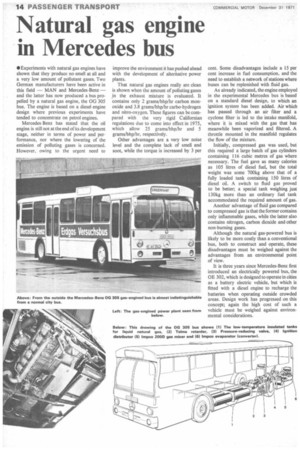Natural gas engine in Mercedes bus
Page 16

If you've noticed an error in this article please click here to report it so we can fix it.
• Experiments with natural gas engines have shown that they produce no smell at all and a very low amount of pollutant gases. Two German manufacturers have been active in this field — MAN and Mercedes-Benz — and the latter has now produced a bus propelled by a natural gas engine, the OG 305 bus. The engine is based on a diesel engine design where previous experiments have tended to concentrate on petrol engines.
Mercedes-Benz has stated that the oil engine is still not at the end of its development stage, neither in terms of power and performance, nor where the lowering of the emission of polluting gases is concerned. However, owing to the urgent need to improve the environment it has pushed ahead with the development of alternative power plants.
That natural gas engines really are clean is shown when the amount of polluting gases in the exhaust mixture is evaluated. It contains only 2 grams/bhp/11r carbon monoxide and 3.8 grams/bhp/hr carbo-hydrogen and nitro-oxygen. These figures can be compared with the very rigid Californian regulations due to come into effect in 1975, which allow 25 grams/bhp/hr and 5 grams/bhp/hr, respectively.
Other advantages are a very low noise level and the complete lack of smell and soot, while the torque is increased by 3 per cent. Some disadvantages include a 15 per cent increase in fuel consumption, and the need to establish a network of stations where buses can be replenished with fluid gas.
As already indicated, the engine employed in the experimental Mercedes bus is based on a standard diesel design, to which an ignition system has been added. Air which has passed through an air filter and a cyclone filter is led to the intake manifold, where it is mixed with the gas that has meanwhile been vaporized and filtered. A throttle mounted in the manifold regulates the flow of the mixture.
Initially, compressed gas was used, but this required a large batch of gas cylinders containing 116 cubic metres of gas where necessary. The fuel gave as many calories as 105 litres of diesel fuel, but the total weight was some 700kg above that of a fully loaded tank containing 150 litres of diesel oil. A switch to fluid gas proved to be better, a special tank weighing just 130kg more than an ordinary fuel tank accommodated the required amount of gas.
Another advantage of fluid gas compared to compressed gas is that the former contains only inflammable gases, while the latter also contains nitrogen, carbon dioxide and other non-burning gases.
Although the natural gas-powered bus is likely to be more costly than a conventional bus, both to construct and operate, these disadvantages must be weighed against the advantages from an environmental point of view.
It is three years since Mercedes-Benz first introduced an electrically powered bus, the OE 302, which is designed to operate in cities as a battery electric vehicle, but which is fitted with a diesel engine to recharge the batteries when operating outside crowded areas. Design work has progressed on this concept; again the high cost of such a vehicle must be weighed against environmental considerations.












































































